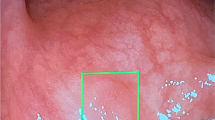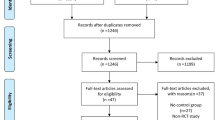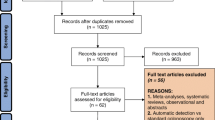Abstract
Purpose of review
To elucidate the advantages and limitations of existing artificial intelligence technologies for colonoscopy by evaluating the currently available eight prospective studies (two for automated polyp detection and six for automated polyp characterization).
Recent findings
AI is expected to mitigate the inherent risk of human error causing a polyp to be missed or mischaracterized by assisting polyp detection and characterization (i.e., pathological prediction). Some of the prospective studies clearly demonstrate the potential for AI to improve adenoma detection rates, which is considered one of the most important quality indicators for colonoscopies, or achieve a > 90% negative predictive value in differentiating diminutive (≤ 5 mm) rectosigmoid adenomas which is considered as a threshold required for optical diagnosis. However, it is also important to consider the negative impacts of AI, such as the deskilling effect on healthcare providers, which has yet to be sufficiently addressed.
Summary
We believe that AI can become standard practice in colonoscopy procedures within several years, given its rapid spread and its expected low implementation cost. However, considering the limited evidence supporting the use of AI for colonoscopy, additional studies should be done to explore the long-term efficacy and safety of AI in colonoscopy and implement robust endpoints such as colorectal cancer incidence and mortality.


Similar content being viewed by others
References and Recommended Reading
Papers of particular interest, published recently, have been highlighted as: • Of importance •• Of major importance
Zauber AG, Winawer SJ, O'Brien MJ, et al. Colonoscopic polypectomy and long-term prevention of colorectal-cancer deaths. N Engl J Med. 2012;366:687–96.
Winawer SJ, Zauber AG, Ho MN, O'Brien MJ, Gottlieb LS, Sternberg SS, et al. Prevention of colorectal cancer by colonoscopic polypectomy. The National Polyp Study Workgroup. N Engl J Med. 1993;329:1977–81.
Corley DA, Jensen CD, Marks AR, et al. Adenoma detection rate and risk of colorectal cancer and death. N Engl J Med. 2014;370:1298–306.
Hassan C, Quintero E, Dumonceau JM, Regula J, Brandão C, Chaussade S, et al. Post-polypectomy colonoscopy surveillance: European Society of Gastrointestinal Endoscopy (ESGE) guideline. Endoscopy. 2013;45:842–51.
• Bisschops R, East JE, Hassan C, et al. Advanced imaging for detection and differentiation of colorectal neoplasia: European Society of Gastrointestinal Endoscopy (ESGE) guideline - Update 2019. Endoscopy. 2019. https://doi.org/10.1055/a-1031-7657.The first clinical guideline mentioning the advantages and limitations of artificial intelligence (AI).
• Vinsard DG, Mori Y, Misawa M, et al. Quality assurance of computer-aided detection and diagnosis in colonoscopy. Gastrointest Endosc. 2019;90:55–63 A review article focused on how we should improve the quality of AI in colonoscopy in terms of technology and study design.
Kudo SE, Misawa M, Mori Y, et al. Artificial intelligence-assisted system improves endoscopic identification of colorectal neoplasms. Clin Gastroenterol Hepatol. 2019. https://doi.org/10.1016/j.cgh.2019.09.009.
Hassan C, Wallace MB, Sharma P, et al. New artificial intelligence system: first validation study versus experienced endoscopists for colorectal polyp detection. Gut. 2019. https://doi.org/10.1136/gutjnl-2019-319914.
• Rath T, Tontini GE, Vieth M, et al. In vivo real-time assessment of colorectal polyp histology using an optical biopsy forceps system based on laser-induced fluorescence spectroscopy. Endoscopy. 2016;48:557–62. A prospective study investigating the performance of AI for the laser-induced fluorescence spectroscopy.
Fernandez-Esparrach G, Bernal J, Lopez-Ceron M, et al. Exploring the clinical potential of an automatic colonic polyp detection method based on the creation of energy maps. Endoscopy. 2016;48:837–42.
Misawa M, Kudo SE, Mori Y, et al. Artificial intelligence-assisted polyp detection for colonoscopy: initial experience. Gastroenterology. 2018;154:2027–9 e2023.
Urban G, Tripathi P, Alkayali T, et al. Deep learning localizes and identifies polyps in real time with 96% accuracy in screening colonoscopy. Gastroenterology. 2018;155:1069–78 e1068.
• Klare P, Sander C, Prinzen M, et al. Automated polyp detection in the colorectum: a prospective study (with videos). Gastrointest Endosc. 2018. https://doi.org/10.1016/j.gie.2018.09.042.The first prospective study investigating the performance of AI for polyp detection.
Figueiredo PN, Figueiredo IN, Pinto L, Kumar S, Tsai YR, Mamonov AV. Polyp detection with computer-aided diagnosis in white light colonoscopy: comparison of three different methods. Endosc Int Open. 2019;7:E209–e215.
Yamada M, Saito Y, Imaoka H, et al. Development of a real-time endoscopic image diagnosis support system using deep learning technology in colonoscopy. Sci Rep. 2019;9:14465.
•• Wang P, Berzin TM, et al. Real-time automatic detection system increases colonoscopic polyp and adenoma detection rates: a prospective randomised controlled study. Gut. in press.Largest-ever prospective study (N = 1058) of automated polyp detection.
Takemura Y, Yoshida S, Tanaka S, Onji K, Oka S, Tamaki T, et al. Quantitative analysis and development of a computer-aided system for identification of regular pit patterns of colorectal lesions. Gastrointest Endosc. 2010;72:1047–51.
Tischendorf JJ, Gross S, Winograd R, Hecker H, Auer R, Behrens A, et al. Computer-aided classification of colorectal polyps based on vascular patterns: a pilot study. Endoscopy. 2010;42:203–7.
Gross S, Trautwein C, Behrens A, Winograd R, Palm S, Lutz HH, et al. Computer-based classification of small colorectal polyps by using narrow-band imaging with optical magnification. Gastrointest Endosc. 2011;74:1354–9.
Takemura Y, Yoshida S, Tanaka S, Kawase R, Onji K, Oka S, et al. Computer-aided system for predicting the histology of colorectal tumors by using narrow-band imaging magnifying colonoscopy (with video). Gastrointest Endosc. 2012;75:179–85.
• Kominami Y, Yoshida S, Tanaka S, et al. Computer-aided diagnosis of colorectal polyp histology by using a real-time image recognition system and narrow-band imaging magnifying colonoscopy. Gastrointest Endosc. 2016;83:643–9.A prospective study investigating the performance of AI for magnified narrow-band imaging.
Tamai N, Saito Y, Sakamoto T, et al. Effectiveness of computer-aided diagnosis of colorectal lesions using novel software for magnifying narrow-band imaging: a pilot study. Endosc Int Open. 2017;5:E690–4.
Chen PJ, Lin MC, Lai MJ, Lin JC, Lu HH, Tseng VS. Accurate classification of diminutive colorectal polyps using computer-aided analysis. Gastroenterology. 2018;154:568–75.
Byrne MF, Chapados N, Soudan F, Oertel C, Linares Pérez M, Kelly R, et al. Real-time differentiation of adenomatous and hyperplastic diminutive colorectal polyps during analysis of unaltered videos of standard colonoscopy using a deep learning model. Gut. 2019;68:94–100.
Min M, Su S, He W, et al. Computer-aided diagnosis of colorectal polyps using linked color imaging colonoscopy to predict histology. Sci Rep. 2019;9:2881.
Mori Y, Kudo SE, Wakamura K, Misawa M, Ogawa Y, Kutsukawa M, et al. Novel computer-aided diagnostic system for colorectal lesions by using endocytoscopy (with videos). Gastrointest Endosc. 2015;81:621–9.
Mori Y, Kudo SE, Chiu PW, Singh R, Misawa M, Wakamura K, et al. Impact of an automated system for endocytoscopic diagnosis of small colorectal lesions: an international web-based study. Endoscopy. 2016;48:1110–8.
Misawa M, Kudo SE, Mori Y, et al. Characterization of colorectal lesions using a computer-aided diagnostic system for narrow-band imaging endocytoscopy. Gastroenterology. 2016;150:1531–2 e1533.
Takeda K, Kudo S, Mori Y, Misawa M, Kudo T, Wakamura K, et al. Accuracy of diagnosing invasie colorectal cancer using computer-aided endocytoscopy. Endoscopy. 2017;49:798–802.
•• Mori Y, Kudo SE, Misawa M, et al. Real-time use of artificial intelligence in identification of diminutive polyps during colonoscopy: a prospective study. Ann Intern Med. 2018;169:357–66.Largest-ever prospective study (N = 791) of automated polyp characterization.
Andre B, Vercauteren T, Buchner AM, et al. Software for automated classification of probe-based confocal laser endomicroscopy videos of colorectal polyps. World J Gastroenterol. 2012;18:5560–9.
Stefanescu D, Streba C, Cartana ET, et al. Computer aided diagnosis for confocal laser endomicroscopy in advanced colorectal adenocarcinoma. PLoS One. 2016;11:e0154863.
• Kuiper T, Alderlieste YA, Tytgat KM, et al. Automatic optical diagnosis of small colorectal lesions by laser-induced autofluorescence. Endoscopy. 2015;47:56–62.Another prospective study investigating the performance of AI for the laser-induced fluorescence spectroscopy.
• Aihara H, Saito S, Inomata H, et al. Computer-aided diagnosis of neoplastic colorectal lesions using 'real-time' numerical color analysis during autofluorescence endoscopy. Eur J Gastroenterol Hepatol. 2013;25:488–94 A prospective study investigating the performance of AI for autofluorescence endoscopy.
Inomata H, Tamai N, Aihara H, Sumiyama K, Saito S, Kato T, et al. Efficacy of a novel auto-fluorescence imaging system with computer-assisted color analysis for assessment of colorectal lesions. World J Gastroenterol. 2013;19:7146–53.
• Horiuchi H, Tamai N, Kamba S et al. Real-time computer-aided diagnosis of diminutive rectosigmoid polyps using an auto-fluorescence imaging system and novel color intensity analysis software. Scand J Gastroenterol. 2019;1–6. https://doi.org/10.1080/00365521.2019.1627407.The larger-scale prospective study investigating the performance of AI for autofluorescence endoscopy.
Komeda Y, Handa H, Watanabe T, et al. Computer-aided diagnosis based on convolutional neural network system for colorectal polyp classification: preliminary experience. Oncology. 2017;93(Suppl 1):30–4.
Ito N, Kawahira H, Nakashima H et al. Endoscopic diagnostic support system for cT1b colorectal cancer using deep learning. Oncology. 2018. https://doi.org/10.1159/000491636: 1-7.
Renner J, Phlipsen H, Haller B, Navarro-Avila F, Saint-Hill-Febles Y, Mateus D, et al. Optical classification of neoplastic colorectal polyps - a computer-assisted approach (the COACH study). Scand J Gastroenterol. 2018;53:1100–6.
Sanchez-Montes C, Sanchez FJ, Bernal J, et al. Computer-aided prediction of polyp histology on white light colonoscopy using surface pattern analysis. Endoscopy. 2019;51:261–5.
Lui TKL, Wong KKY, Mak LLY, et al. Endoscopic prediction of deeply submucosal invasive carcinoma with use of artificial intelligence. Endosc Int Open. 2019;7:E514–e520.
Rex DK, Kahi C, O'Brien M, Levin TR, Pohl H, Rastogi A, et al. The American Society for Gastrointestinal Endoscopy PIVI (preservation and incorporation of valuable endoscopic innovations) on real-time endoscopic assessment of the histology of diminutive colorectal polyps. Gastrointest Endosc. 2011;73:419–22.
Committee AT, Abu Dayyeh BK, Thosani N, et al. ASGE Technology Committee systematic review and meta-analysis assessing the ASGE PIVI thresholds for adopting real-time endoscopic assessment of the histology of diminutive colorectal polyps. Gastrointest Endosc. 2015;81:502 e501–16.
Ladabaum U, Fioritto A, Mitani A, Desai M, Kim JP, Rex DK, et al. Real-time optical biopsy of colon polyps with narrow band imaging in community practice does not yet meet key thresholds for clinical decisions. Gastroenterology. 2013;144:81–91.
Rees CJ, Rajasekhar PT, Wilson A, Close H, Rutter MD, Saunders BP, et al. Narrow band imaging optical diagnosis of small colorectal polyps in routine clinical practice: the detect inspect characterise resect and Discard 2 (DISCARD 2) study. Gut. 2017;66:887–95.
Park SH, Han K. Methodologic guide for evaluating clinical performance and effect of artificial intelligence technology for medical diagnosis and prediction. Radiology. 2018;286:800–9.
Mori Y, Kudo S, Ikehara N, Wakamura K, Wada Y, Kutsukawa M, et al. Comprehensive diagnostic ability of endocytoscopy compared with biopsy for colorectal neoplasms: a prospective randomized noninferiority trial. Endoscopy. 2013;45:98–105.
Renkoski TE, Banerjee B, Graves LR, et al. Ratio images and ultraviolet C excitation in autofluorescence imaging of neoplasms of the human colon. J Biomed Opt. 2013;18:16005.
Arita K, Mitsuyama K, Kawano H, et al. Quantitative analysis of colorectal mucosal lesions by autofluorescence endoscopy: discrimination of carcinomas from other lesions. Oncol Rep. 2011;26:43–8.
SERVICES DOHAH, Administration FaD. Radiology devices; reclassification of medical image analyzers. 2018. Available from: https://s3.amazonaws.com/public-inspection.federalregister.gov/2018-11880.pdf.
Park SH. Regulatory approval versus clinical validation of artificial intelligence diagnostic tools. Radiology. 2018;288:910–1.
Chinzei K, Shimizu A, Mori K, et al. Regulatory science on AI-based medical devices and systems. Adv Biomed Eng. 2018;7:118–23.
Acknowledgments
We thank Stephanie Knowlton, PhD, from Edanz Group (https://en-author-services.edanzgroup.com/) for editing a draft of this manuscript.
Author information
Authors and Affiliations
Corresponding author
Ethics declarations
Conflict of Interest
YM, SK, and MM have received speaking honoraria from Olympus Corp. KM received research funding from Cybernet Corp. None of the other authors has conflicts of interest relating to the present study/paper.
Additional information
Publisher’s Note
Springer Nature remains neutral with regard to jurisdictional claims in published maps and institutional affiliations.
This article is part of the Topical Collection on Endoscopy
Rights and permissions
About this article
Cite this article
Mori, Y., Kudo, Se., Misawa, M. et al. Artificial Intelligence for Colorectal Polyp Detection and Characterization. Curr Treat Options Gastro 18, 200–211 (2020). https://doi.org/10.1007/s11938-020-00287-x
Published:
Issue Date:
DOI: https://doi.org/10.1007/s11938-020-00287-x




